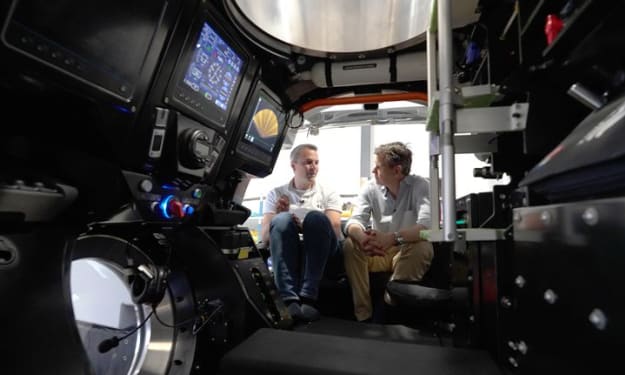Content warning
This story may contain sensitive material or discuss topics that some readers may find distressing. Reader discretion is advised. The views and opinions expressed in this story are those of the author and do not necessarily reflect the official policy or position of Vocal.
Tragedy Strikes: The Catastrophic Loss of the Titan Submersible
The Desperate Search Effort

Tragedy Strikes: The Catastrophic Loss of the Titan Submersible
In a devastating turn of events, the world received distressing news this afternoon at 3 P.M Eastern. After an exhaustive four-day search, the multinational task force leading the mission to locate the five people aboard the Titan submersible announced a heart-wrenching conclusion. The debris discovered points to the catastrophic loss of the pressure chamber, signifying a tragic fate for those on board. Let us delve into the details of this unfortunate incident and explore what transpired during the ill-fated voyage.
1. The Desperate Search Effort
From the moment the news broke, experts from within the unified command spearheaded the relentless search for the Titan submersible and its passengers. Utilizing a wide array of resources such as planes, ships, submarines, subsea robots, and remote-operated vehicles, the search team spared no effort in their quest to locate the vessel. Their primary destination was the wreckage site of the Titanic, lying on the ocean floor.
2. Clues Unveiled: The Discovery of Debris
Amidst the costly and arduous search operation, five major pieces of debris surfaced as significant indicators of the Titan's tragic demise. The U.S Coast Guard reported that a remote-operated vehicle (ROV) meticulously combed the ocean floor in the vicinity of the Titanic wreckage. Several hundred meters away, the search team made their first breakthrough. The discovery of the nose cone, which was found outside the pressure hall, marked the first clue in unraveling the mystery.
3. Unveiling the Debris Field
Shortly after locating the nose cone, the search team stumbled upon a substantial debris field. Within this field, they identified additional components that closely matched the design specifications of the Titan submersible. The subsequent discovery of the other end of the pressure hole, known as the AFT and Bell, completed the puzzle. Collectively, these findings confirmed the remnants of the Titan and its tragic fate.
4. Unmasking a Catastrophic Implosion
The evidence extracted from the debris field paints a harrowing picture of the Titan's demise. The debris suggests a violent and sudden change in pressure rather than a gradual, steady leak. Plunged into the unforgiving depths of the ocean floor, the Titan succumbed to the relentless forces exerted upon its hull. The immense pressure experienced at a depth of approximately 13,000 feet below sea level proved fatal. Comparisons have been made to the equivalent of an Empire State Building crushing the vessel from all sides.
5. Unanswered Questions: Investigating the Tragedy
While the search operation provided crucial insights into the Titan's destruction, the exact cause of the catastrophic implosion remains a haunting enigma. The submersible was an experimental vessel, and the CEO of the company behind its creation had been known for a cavalier attitude toward safety and a relentless pursuit of innovation. Questions linger regarding the role of these factors in the tragic incident. Authorities are determined to unravel the circumstances surrounding this catastrophic event.
6. The Timing of Tragedy
Another key aspect that emerged during the news conference sheds light on the timeline leading up to the implosion. The Titan lost contact with its mothership on the surface during its descent on Sunday morning. Astonishingly, this critical information only reached the Coast Guard later that evening. It wasn't until approximately a day later that Canadian planes dropped sonar buoys into the water, aiding the search with underwater microphones. The absence of any indication during this period suggests that the implosion likely occurred in that window of uncertainty, leaving no hope for survival.
7. A Glimmer of Light in the Darkness
As we attempt to grasp the immense tragedy, it is essential to reflect on the fate of those on board the Titan. The environment at the depths of the sea offers little solace, with limited supplies of food, water, and oxygen. However, amidst the grim circumstances, there is a silver lining. In the case of a violent implosion, death would have been instantaneous, sparing the victims from prolonged suffering.
Conclusion
The loss of the Titan submersible and the lives aboard is a devastating blow to the exploratory community and the families of the passengers. Our thoughts and condolences go out to the grieving families during this unimaginably difficult time. The discovery of the wreckage, not far from the site where the Titanic met its tragic end a century ago, offers closure but also serves as a poignant reminder of the risks and challenges that come with pushing the boundaries of human exploration.
FAQs
Q: How deep was the Titan submersible when the implosion occurred?
A: The Titan submersible was approximately 13,000 feet below sea level when the catastrophic implosion took place.
Q: Were there any survivors from the Titan submersible?
A: Unfortunately, there were no survivors. The violent implosion led to the instant loss of all lives on board.
Q: What factors contributed to the catastrophic implosion of the Titan?
A: While investigations are ongoing, the experimental nature of the submersible and potential safety concerns have raised questions about the underlying causes of the tragedy.
Q: How long did it take to locate the debris of the Titan submersible?
A: The multinational task force spent four days tirelessly searching for the wreckage and successfully discovered significant pieces of debris.
Q: What lessons can be learned from this tragic event?
A: The incident underscores the critical importance of prioritizing safety and thorough testing during the development and operation of experimental vessels like the Titan submersible.
The news of the Titan submersible's tragic loss has sent shockwaves through the maritime exploration community. The incident serves as a somber reminder of the inherent risks involved in pushing the boundaries of human ingenuity and venturing into uncharted territories.
The profound loss of life onboard the Titan has reverberated across the globe, drawing attention to the need for enhanced safety protocols and meticulous risk assessment in the realm of deep-sea exploration. The unfortunate fate of the British billionaire explorer Hamish Harding, the renowned French diver Shizita Dawood and his son Suleiman, and the members of one of Pakistan's wealthiest families, along with Stockton Rush, the CEO of Ocean Gate Expeditions, has left a void in the hearts of their loved ones and the wider community.
While the investigation into the exact cause of the catastrophic implosion continues, it is essential to acknowledge the dedication and unwavering commitment of the unified command and all the personnel involved in the search operation. Their tireless efforts, employing state-of-the-art technology and employing diverse resources, demonstrated the resolve of the international community to leave no stone unturned in the quest for answers.
As the families of the victims grapple with this unimaginable tragedy, it is our collective responsibility to offer support, compassion, and understanding during this period of grief and mourning. The outpouring of condolences and solidarity from around the world serves as a testament to the indomitable human spirit and the power of empathy.
In the face of such heartrending news, it is natural for the public to question the safety measures in place during experimental expeditions. The importance of striking a balance between innovation and precaution cannot be overstated. As pioneers of exploration push the limits of what is possible, it is imperative that they remain vigilant in prioritizing safety, ensuring that every endeavor is backed by rigorous testing, and adhering to stringent standards.
In conclusion, the loss of the Titan submersible and its crew is an immense tragedy that highlights the inherent dangers associated with deep-sea exploration. While the investigation into the cause of the catastrophic implosion continues, it is crucial for the maritime community to reflect on the lessons learned and redouble efforts to mitigate risks and prioritize safety in all future endeavors. May the memories of those lost aboard the Titan submersible endure as a testament to their pioneering spirit and unwavering dedication to unlocking the secrets of the ocean depths.
FAQs
Q: What is the significance of the wreckage being near the site of the Titanic's sinking?
A: The proximity of the Titan wreckage to the Titanic's resting place serves as a poignant reminder of the perils of deep-sea exploration and the enduring legacy of the Titanic disaster.
Q: What role did the multinational task force play in the search for the Titan submersible?
A: The multinational task force spearheaded the search operation, utilizing a range of resources and expertise to locate and recover the debris from the Titan submersible.
Q: How can the maritime exploration community prevent similar incidents in the future?
A: By placing a paramount emphasis on safety, conducting thorough risk assessments, and adhering to rigorous testing protocols, the maritime exploration community can work towards minimizing the occurrence of such tragic incidents.
Q: What support systems are available for the families affected by this tragedy?
A: The families of the victims can seek solace and support from grief counseling services, community networks, and organizations dedicated to providing assistance to those affected by maritime incidents.
Q: What is the long-term impact of this incident on the field of deep-sea exploration?
A: The loss of the Titan submers
ible and its crew will undoubtedly have a profound impact on the field of deep-sea exploration. It will likely lead to a reevaluation of safety protocols, further research and development of submersibles, and a renewed focus on risk mitigation strategies. The lessons learned from this tragedy will shape future expeditions, ensuring that the pursuit of knowledge and discovery is accompanied by a steadfast commitment to the well-being and security of all involved.
The maritime community must come together to support one another during this difficult time. It is essential to foster an environment where open dialogue and shared knowledge can help prevent similar incidents in the future. Collaboration, transparency, and continuous improvement will be key in ensuring the safety and success of future deep-sea exploration missions.
As we mourn the loss of the Titan submersible and its crew, let us also honor their memory by recognizing the courage, curiosity, and passion that drove them to explore the depths of the ocean. Their legacy will endure as a reminder of the boundless human spirit and the unyielding quest for knowledge that defines our species.





Comments
There are no comments for this story
Be the first to respond and start the conversation.